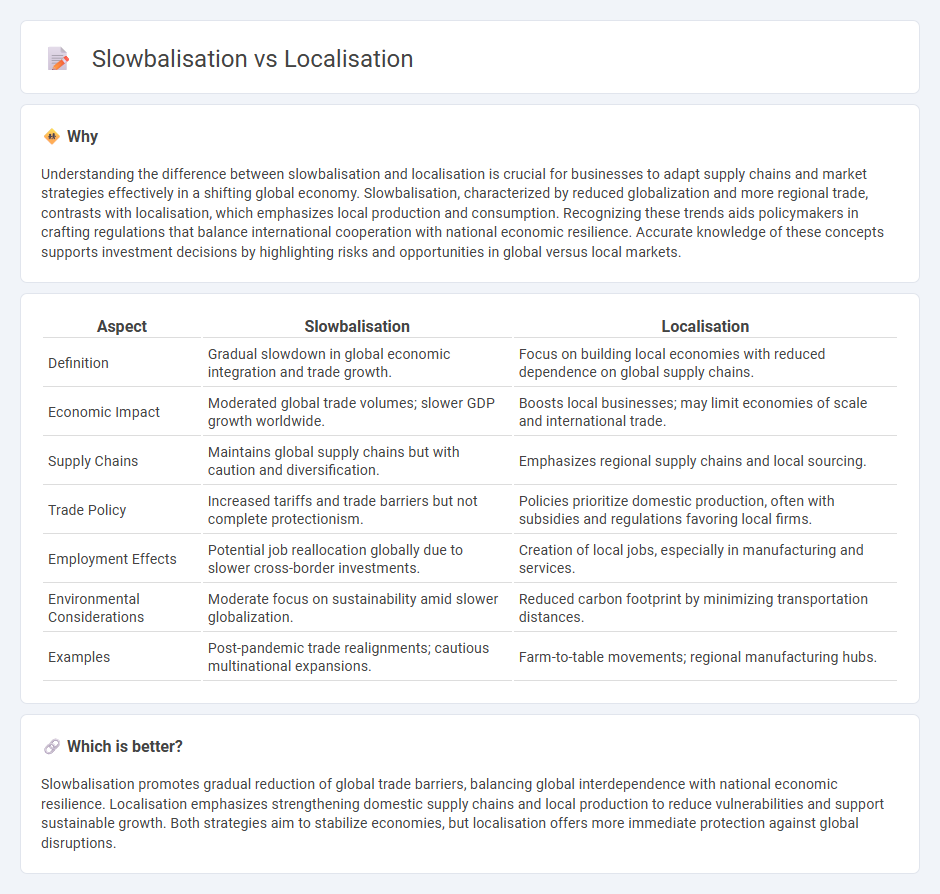
Slowbalisation reflects the gradual deceleration of global economic integration due to rising trade barriers and regional conflicts, impacting multinational supply chains and international investments. Localisation emphasizes strengthening domestic production, reducing dependence on foreign markets, and fostering local industries for economic resilience. Explore how these competing trends reshape global economic strategies and future growth opportunities.
Why it is important
Understanding the difference between slowbalisation and localisation is crucial for businesses to adapt supply chains and market strategies effectively in a shifting global economy. Slowbalisation, characterized by reduced globalization and more regional trade, contrasts with localisation, which emphasizes local production and consumption. Recognizing these trends aids policymakers in crafting regulations that balance international cooperation with national economic resilience. Accurate knowledge of these concepts supports investment decisions by highlighting risks and opportunities in global versus local markets.
Comparison Table
| Aspect | Slowbalisation | Localisation |
|---|---|---|
| Definition | Gradual slowdown in global economic integration and trade growth. | Focus on building local economies with reduced dependence on global supply chains. |
| Economic Impact | Moderated global trade volumes; slower GDP growth worldwide. | Boosts local businesses; may limit economies of scale and international trade. |
| Supply Chains | Maintains global supply chains but with caution and diversification. | Emphasizes regional supply chains and local sourcing. |
| Trade Policy | Increased tariffs and trade barriers but not complete protectionism. | Policies prioritize domestic production, often with subsidies and regulations favoring local firms. |
| Employment Effects | Potential job reallocation globally due to slower cross-border investments. | Creation of local jobs, especially in manufacturing and services. |
| Environmental Considerations | Moderate focus on sustainability amid slower globalization. | Reduced carbon footprint by minimizing transportation distances. |
| Examples | Post-pandemic trade realignments; cautious multinational expansions. | Farm-to-table movements; regional manufacturing hubs. |
Which is better?
Slowbalisation promotes gradual reduction of global trade barriers, balancing global interdependence with national economic resilience. Localisation emphasizes strengthening domestic supply chains and local production to reduce vulnerabilities and support sustainable growth. Both strategies aim to stabilize economies, but localisation offers more immediate protection against global disruptions.
Connection
Slowbalisation and localisation are interconnected through their shared impact on global supply chains and trade dynamics, as slowbalisation reflects a deceleration in global economic integration while localisation emphasizes strengthening domestic markets and production. Both trends promote economic resilience by reducing dependence on distant markets and encouraging self-sufficiency, which can mitigate risks associated with geopolitical tensions and supply chain disruptions. This shift reshapes international trade patterns and compels multinational corporations to adapt strategies that balance global reach with local responsiveness.
Key Terms
Supply Chain
Localisation in supply chain management emphasizes sourcing, production, and distribution within close geographic proximity to reduce lead times, transportation costs, and supply chain risks. Slowbalisation advocates for a balanced approach, combining regional hubs and global networks to enhance resilience while maintaining cost efficiency. Explore how businesses optimize supply chains by integrating these strategies for competitive advantage.
Trade Barriers
Trade barriers impact localisation by encouraging countries to produce goods domestically, reducing dependence on international supply chains. In contrast, slowbalisation reflects a strategic slowdown in global trade integration, driven by rising tariffs, stricter regulatory controls, and geopolitical tensions that elevate trade barriers. Explore further to understand how evolving trade policies shape global economic patterns.
Regionalization
Regionalization emphasizes strengthening local economies and supply chains within specific geographic areas, contrasting with slowbalisation, which reflects a global economic slowdown and reduced cross-border integration. This approach promotes resilience by prioritizing regional trade agreements, cultural affinity, and resource optimization tailored to localized demands. Explore how regionalization reshapes global markets and influences future economic strategies.
Source and External Links
LOCALIZATION definition | Cambridge English Dictionary - Localization is the process of organizing a business or industry so that its main activities happen in local areas rather than nationally or internationally, and it also refers to adapting products for local markets such as translation and cultural alignment.
What is Localisation? | Lexika - Localisation refers to adapting a product or service translation to meet the specific cultural, linguistic, and legal standards of a target local market, distinct from but related to broader translation services.
Language localisation - Wikipedia - Language localisation is the process of adapting a product's translation to a specific country or region, typically following internationalisation which prepares the product for such adaptation by removing cultural assumptions.
 dowidth.com
dowidth.com